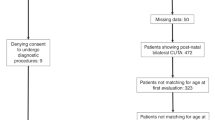Abstract
Congenital solitary functioning kidney (CSFK) is a relatively common renal malformation and in children is frequently complicated by anomalies of the ipsilateral genital organs and occasionally by anomalies of other organs. The aim of this study was to determine the incidence of associated urological, cardiac, gastrointestinal, hematological, neurological, skeletal, and other congenital malformations in children with CSFK. We retrospectively reviewed 87 consecutive cases of CSFK diagnosed at our hospital between 1995 and 2003. There were 45 boys and 42 girls, whose ages at diagnosis ranged from newborn to 16 years (mean 4.67±4.48 years). In all patients, CSFK was diagnosed by abdominal ultrasound and confirmed by radionuclide studies. In 46 patients (53%) the left kidney was absent, and in 41 patients (47%) the right kidney was absent. Overall associated anomalies were detected in 52 of the 87 children (60%) with CSFK. Urological anomalies were most common, with an incidence of 37% (32/87). Nonurological anomalies were detected in 38 children (44%) with CSFK; these included cardiac anomalies in 13, gastrointestinal anomalies in eight, hematological anomalies in five, neurological anomalies in three, and other organ anomalies in nine. In our study, more than half of the patients with CSFK had associated anomalies. For this reason we recommend abdominal ultrasound and voiding cystourethrogram for early recognition of urological anomalies and a careful physical examination for other organ anomalies in patients with CSFK.
Similar content being viewed by others
References
Arant BS Jr (1991) Vesicoureteric reflux and renal injury. Am J Kidney Dis 17:491–511
Atiyeh B, Husmann D, Baum M (1993) Contralateral renal abnormalities in patients with renal agenesis and noncystic renal dysplasia. Pediatrics 91:812–815
Candiani GB, Fedele L, Candiani M (1997) Double uterus blind hemivagina and ipsilateral renal agenesis: 36 cases and long-term follow-up. Obstet Gynecol 90:26–32
Cascio S, Paran S, Puri P (1999) Associated urological anomalies in children with unilateral renal agenesis. J Urol 162:1081–1083
Doroshow LW, Abeshouse BS (1961) Congenital unilateral solitary kidney: report of 37 cases and a review of the literature. Urol Surv 11:219–229
Elder JS (1996) Management of antenatally detected hydronephrosis. In: Puri P (ed) Newborn surgery. Butterworth-Heinemann, Oxford, pp 575–585
Emanuel B, Nachman R, Aronson N, Weiss H (1974) Congenital solitary kidney: a review of 74 cases. J Urol 111:394–397
Flynn MT, Ekstrom L, De Arce M, Costigan C, Hoey HM (1996) Prevalence of renal malformation in Turner syndrome. Pediatr Nephrol 10:498–500
Grotewold CG, Gonzalez R (1997) Abnormalities of the kidney. In: O’Donnell B (ed) Pediatric urology. Butterworth-Heinemann, Oxford, pp 339–354
Hiraoka M, Tsukahara H, Ohshima Y, Kasuga K, Ishihara Y, Mayumi M (2002) Renal aplasia is the predominant cause of congenital solitary kidneys. Kidney Int 61:1840–1844
Jancu J, Zuckerman H, Sudarsky M (1976) Unilateral renal agenesis associated with multiple skeletal abnormalities. South Med J 69:94–96
Kaneyama K, Yamataka A, Satake S, Yanai T, Lane GJ, Kaneko K, Yamashiro Y, Miyano T (2004) Associated urological anomalies in children with solitary kidney. J Pediatr Surg 39:85–87
Kass EJ, Bloom D (1992) Anomalies of the urinary tract. In: Edelman CM (ed) Pediatric kidney disease. Little Brown, Boston, pp 2023–2035
Mesrobian HG, Rushton HG, Bulas D (1993) Unilateral renal agenesis may result from in utero regression of multicystic renal dysplasia. J Urol 150:793–794
Potter EL (1965) Bilateral absence of ureters and kidneys: a report of 50 cases. Obstet Gynecol 25:3–12
Robson WL, Leung AK, Rogers RC (1995) Unilateral renal agenesis. Adv Pediatr 42:575–592
Song JT, Ritchey ML, Zerrin M, Bloom D (1995) Incidence of vesicoureteral reflux in children with unilateral renal agenesis. J Urol 153:1249–1252
Stoll C, Alembik Y, Roth MP, Dott B, Sauvage P (1990) Risk factors in internal urinary system malformations. Pediatr Nephrol 4:319–323
Wilson RD, Baird PA (1985) Renal agenesis in British Columbia. Am J Med Genet 21:153–169
Author information
Authors and Affiliations
Corresponding author
Rights and permissions
About this article
Cite this article
Dursun, H., Bayazıt, A.K., Büyükçelik, M. et al. Associated anomalies in children with congenital solitary functioning kidney. Ped Surgery Int 21, 456–459 (2005). https://doi.org/10.1007/s00383-005-1408-7
Accepted:
Published:
Issue Date:
DOI: https://doi.org/10.1007/s00383-005-1408-7




